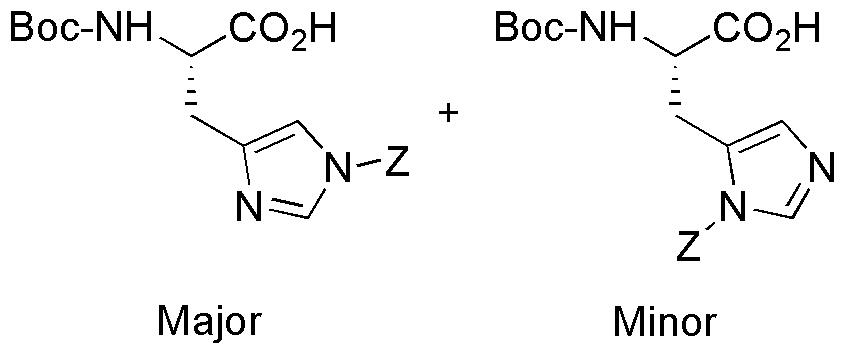Na-Boc-Nim-Z-L-histidine is widely utilized in research focused on:
- Peptide Synthesis: This compound serves as a protective group in the synthesis of peptides, allowing for selective reactions and improving yield. Its stability under various conditions makes it a preferred choice for researchers in organic chemistry.
- Drug Development: In pharmaceutical research, it is used to create histidine derivatives that can enhance drug efficacy. By modifying histidine, researchers can develop new therapeutic agents targeting specific diseases.
- Bioconjugation: The compound is valuable in bioconjugation processes, where it aids in attaching biomolecules to surfaces or other molecules. This application is crucial in developing targeted drug delivery systems.
- Protein Engineering: It plays a significant role in protein engineering, where it is used to modify histidine residues in proteins, improving their stability and functionality for various applications in biotechnology.
- Research in Catalysis: The compound is also explored in catalytic processes, particularly in asymmetric synthesis. Its unique structure can facilitate reactions that are essential in creating complex organic molecules.
Información general
Propiedades
Seguridad y normativas
Aplicaciones
Na-Boc-Nim-Z-L-histidine is widely utilized in research focused on:
- Peptide Synthesis: This compound serves as a protective group in the synthesis of peptides, allowing for selective reactions and improving yield. Its stability under various conditions makes it a preferred choice for researchers in organic chemistry.
- Drug Development: In pharmaceutical research, it is used to create histidine derivatives that can enhance drug efficacy. By modifying histidine, researchers can develop new therapeutic agents targeting specific diseases.
- Bioconjugation: The compound is valuable in bioconjugation processes, where it aids in attaching biomolecules to surfaces or other molecules. This application is crucial in developing targeted drug delivery systems.
- Protein Engineering: It plays a significant role in protein engineering, where it is used to modify histidine residues in proteins, improving their stability and functionality for various applications in biotechnology.
- Research in Catalysis: The compound is also explored in catalytic processes, particularly in asymmetric synthesis. Its unique structure can facilitate reactions that are essential in creating complex organic molecules.
Documentos
Hojas de datos de seguridad (HDS)
La SDS proporciona información de seguridad completa sobre la manipulación, el almacenamiento y la eliminación del producto.
Especificación del producto (PS)
La PS proporciona un desglose completo de las propiedades del producto, incluida la composición química, el estado físico, la pureza y los requisitos de almacenamiento. También detalla los rangos de calidad aceptables y las aplicaciones previstas del producto.
Certificados de análisis (COA)
Busque certificados de análisis (COA) ingresando el número de lote del producto. Los números de lote y de partida se pueden encontrar en la etiqueta de un producto después de las palabras "Lote" o "Lote".
Número de catálogo
Número de lote/lote
Certificados de origen (COO)
Este certificado de origen confirma el país en el que se fabricó el producto y también detalla los materiales y componentes utilizados en él y si se deriva de fuentes naturales, sintéticas u otras fuentes específicas. Este certificado puede ser necesario para cumplir con las normativas aduaneras, comerciales y regulatorias.
Número de catálogo
Número de lote/lote
Hojas de datos de seguridad (HDS)
La SDS proporciona información de seguridad completa sobre la manipulación, el almacenamiento y la eliminación del producto.
DownloadEspecificación del producto (PS)
La PS proporciona un desglose completo de las propiedades del producto, incluida la composición química, el estado físico, la pureza y los requisitos de almacenamiento. También detalla los rangos de calidad aceptables y las aplicaciones previstas del producto.
DownloadCertificados de análisis (COA)
Busque certificados de análisis (COA) ingresando el número de lote del producto. Los números de lote y de partida se pueden encontrar en la etiqueta de un producto después de las palabras "Lote" o "Lote".
Número de catálogo
Número de lote/lote
Certificados de origen (COO)
Este certificado de origen confirma el país en el que se fabricó el producto y también detalla los materiales y componentes utilizados en él y si se deriva de fuentes naturales, sintéticas u otras fuentes específicas. Este certificado puede ser necesario para cumplir con las normativas aduaneras, comerciales y regulatorias.

